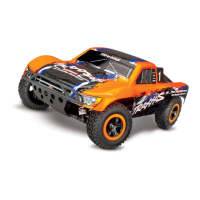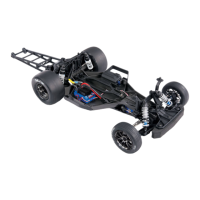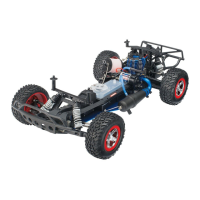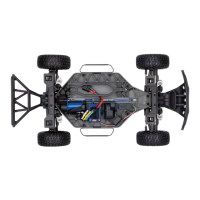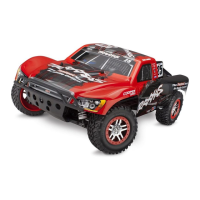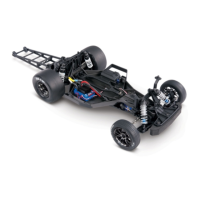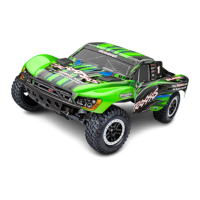Do you have a question about the Traxxas SLASH and is the answer not in the manual?
Contact Traxxas for technical support and register your new model online for better customer service.
Key reminders for safe operation, including avoiding crowds, interference, and hot components.
Precautions for the electronic speed control, including motor limits, wiring, and battery voltage.
Critical warnings and precautions for handling and charging Lithium Polymer (LiPo) batteries safely.
List of specialty metric tools included with the model for assembly and maintenance.
Essential items like batteries and chargers needed to operate the model.
Suggested tools and supplies for an R/C toolbox to enhance maintenance and operation.
Visual identification of key parts and components of the Traxxas Slash model.
Step-by-step guide to get your model up and running quickly and safely.
Instructions on how to apply optional decals to customize your model's appearance.
Definitions of essential terms related to the radio system and power components.
Important guidelines for maintaining radio range and preventing signal loss.
How to install AA batteries into the TQ 2.4GHz transmitter correctly.
Guidance on choosing compatible batteries and chargers for optimal performance and safety.
Step-by-step instructions for correctly installing the battery pack into the model.
Essential rules for operating the radio system, including transmitter on/off sequence.
Details on steering trim, channel reversing, and basic radio system adjustments.
How to operate the transmitter, check servo function, and perform range tests.
Procedures to ensure the radio system operates properly at various distances.
Understanding LED indicators and procedures for binding the transmitter and receiver.
Proper installation of the receiver antenna and tube for optimal radio range.
Technical specifications for the XL-5 electronic speed control, including voltage and motor limits.
How to activate or disable Low-Voltage Detection for LiPo or NiMH battery compatibility.
Steps to calibrate the speed control and transmitter for correct operation.
How to select between Sport, Race, and Training modes for different driving styles.
Explanation of LED indicators and protection modes like thermal shutdown and low voltage.
Procedure to re-center the speed control if throttle neutral position changes.
Important safety and operational advice for driving the model, including cooling and battery indicators.
Strategies to maximize battery run time, such as using high-capacity batteries and proper charging.
Guidelines and precautions for operating the model in wet environments.
Procedures for draining tires, cleaning, and protecting components after running in wet conditions.
Instructions for removing and installing the receiver while maintaining the watertight seal.
How to adjust the slipper clutch for optimal tire grip and drivetrain protection.
Information on motor types, gear ratios, and calculating overall gear ratios for performance.
How to set the gear mesh correctly to prevent stripped spur gears.
Steps to set toe-in and camber angles for precise steering and stability.
Guidance on adjusting shocks with different oils and springs for suspension tuning.
Procedure to re-center the steering servo horn after service or cleaning.
Checklist for inspecting the model for wear, damage, and binding.
Regular maintenance for slipper clutch pads, chassis, and steering components.
Procedures for cleaning and lubricating the motor and maintaining shock oil levels.
Inspecting suspension pins, turnbuckles, drive yokes, and driveline for wear.
How to properly store the model and remove batteries for long-term storage.
The Traxxas Slash (Model 58024) is a high-performance, short-course race truck designed for intense fender-to-fender, high-flying off-road action. It's a radio-controlled (RC) model that offers a thrilling and safe driving experience when operated responsibly. The model is equipped with a TQ 2.4GHz radio system, an XL-5 electronic speed control, and a Titan 12T 550 motor, making it suitable for both beginners and advanced users.
The Traxxas Slash is designed for recreational driving and racing on various terrains, including dirt, grass, and paved surfaces. Its primary function is to provide an exciting and responsive RC driving experience, mimicking the performance of full-size short-course race trucks. The model is controlled remotely via a hand-held transmitter, allowing the user to steer, accelerate, and brake.
The TQ 2.4GHz radio system ensures reliable control by automatically selecting and locking onto an open frequency, minimizing interference and "glitching." This allows multiple models to be raced together without frequency conflicts. The transmitter features a steering wheel for directional control and a throttle trigger for speed and braking. The receiver, located within the model, translates these signals into actions by the steering servo and electronic speed control.
The XL-5 electronic speed control (ESC) is a powerful device that provides precise, digital proportional throttle control. It efficiently manages power flow to the motor, extending battery run times. The ESC includes built-in Low-Voltage Detection, which is crucial for LiPo battery users, as it alerts the driver when the battery reaches its minimum safe discharge voltage. This feature helps prevent over-discharge and potential battery damage. The ESC also offers thermal shutdown protection, automatically shutting down if excessive temperatures are detected, safeguarding the electronics from damage.
The Titan 12T 550 motor, a larger and more powerful motor compared to standard 540 size motors, provides strong acceleration and high top speeds. It is equipped with an integrated cooling fan and a vented gearbox to help manage motor temperatures during operation.
The model's suspension system is designed for off-road performance, with adjustable shock mounting positions to adapt to different terrains and driving styles. The slipper clutch, integrated into the spur gear, regulates power to the rear wheels, preventing tire spin and protecting the drivetrain.
The Traxxas Slash is designed for ease of use, even for those with no prior RC experience. The Quick Start guide provides a step-by-step overview to get the model running quickly, while the full manual offers detailed instructions for proper operation and maintenance.
Before operating, users must install 4 AA batteries in the transmitter and a fully charged battery pack (either NiMH or 2S LiPo with a Traxxas High-Current Connector) in the model. The battery compartment is designed to accommodate different battery configurations, including stick packs and side-by-side racing style packs.
The radio system requires a range test before each running session to ensure proper operation and prevent signal loss. The transmitter's status LED indicates battery strength and binding status, while the receiver's LED provides information on normal operation, binding, and fail-safe activation.
The model is equipped with water-resistant features, allowing it to be driven through puddles, wet grass, and snow. However, it's important to note that it is not fully waterproof, and additional care and maintenance are required after wet conditions to prevent corrosion and maintain performance. The receiver box is designed to maintain a watertight seal, protecting the sensitive electronics.
The XL-5 ESC offers three selectable profiles:
These profiles can be easily selected through a simple programming sequence using the EZ-Set button on the ESC. The Low-Voltage Detection feature can be activated for LiPo batteries or disabled for NiMH batteries, ensuring safe operation with different battery chemistries.
Adjustments can be made to the model's handling characteristics, such as toe-in and camber angles, using the supplied turnbuckles. The slipper clutch can be adjusted to fine-tune power delivery and prevent tire spin. Gearing can also be changed by installing different pinion and spur gears to optimize for either faster acceleration or higher top speed, depending on the driving environment and desired performance.
Regular maintenance is crucial for keeping the Traxxas Slash in top running condition and extending its lifespan. The manual outlines several periodic maintenance procedures:
The manual also provides guidance on proper battery charging and disposal, emphasizing the importance of using a LiPo charger for LiPo batteries and recycling NiMH batteries at the end of their useful life. Safety precautions are highlighted throughout the manual to ensure safe operation and prevent damage or injury.
| Product type | Car |
|---|---|
| Battery technology | Nickel-Metal Hydride (NiMH) |

